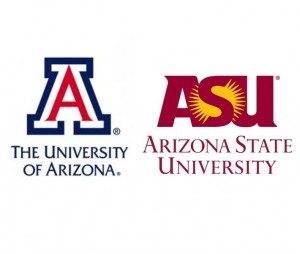 The University of Arizona and Arizona State University have been ranked among the top 80 research universities in the world by the well-respected and influential 2014-2016 Academic Ranking of World Universities by Shanghai Ranking Consultancy.
The University of Arizona and Arizona State University have been ranked among the top 80 research universities in the world by the well-respected and influential 2014-2016 Academic Ranking of World Universities by Shanghai Ranking Consultancy.
The University of Arizona is ranked 78th, while Arizona State University came in at No. 80. Some of the prestigious universities topped by the Arizona universities include Michigan State University, Notre Dame, Rice University, and University of Virginia.
The University of Arizona summary in the published encyclopedia highlights Tech Launch Arizona, which was created to facilitate the transfer of discoveries into intellectual property, inventions, and technology. The description states that Tech Launch Arizona also supports UA’s robust entrepreneurial approach to company startups and investment.
The summary states that the space sciences stand out at Tucson-based UA, which is awarded the most NASA grants for space exploration in the country. The university is currently building the Giant Magellan Telescope, which will be the world’s most advanced.
Arizona State University has an “intellectual fusion” strategy that has resulted in significant increases in research productivity and recognition, according to the summary of the Tempe-based university. One example is the Biodesign Institute, where scientists are studying a new approach to virology by investigating the ability to combat viruses without vaccines. ASU researchers also determined the 3D structure of a protein through serial femtosecond nanocrystallography, which could open up new avenues for drugs to treat diseases.
As for technology transfer, ASU focuses on quickly moving new technologies into the marketplace and prioritizing impact on society, according to the summary. The university also has nearly 11,000 students involved in entrepreneurial activities.
Academic Ranking of World Universities ranks about 1,200 public and private universities a year and the top 500 are published. The rankings look at outcomes and impact over many years, do not penalize an institution for accessibility, and are international in scope. The rankings are based on objective facts such as the number of staff and alumni winning Nobel Prizes and Fields Medals, the number of articles published in the premiere journals Nature and Science and indexed in Science Citation Index, the number of highly cited researchers, and the per-capita performance of a university. Direct interviews are conducted with the world’s leading universities as well.
The rankings were first published in 2003 and are updated on an annual basis. They initiated from China’s desire to expand its number of world-class universities. The ranking system was developed by a team at Shanghai Jiao Tong University, a public research university located in Shanghai, China, and U.S. researchers.
While the list of ranked universities is dominated by U.S. institutions, many other nations are represented, including Brazil, Canada, China, France, Germany, Italy, Japan, Saudi Arabia, Singapore, and the United Kingdom.
The top five institutions in the rankings are Harvard University, Stanford University, the University of California at Berkeley, Massachusetts Institute of Technology, and the University of Cambridge.